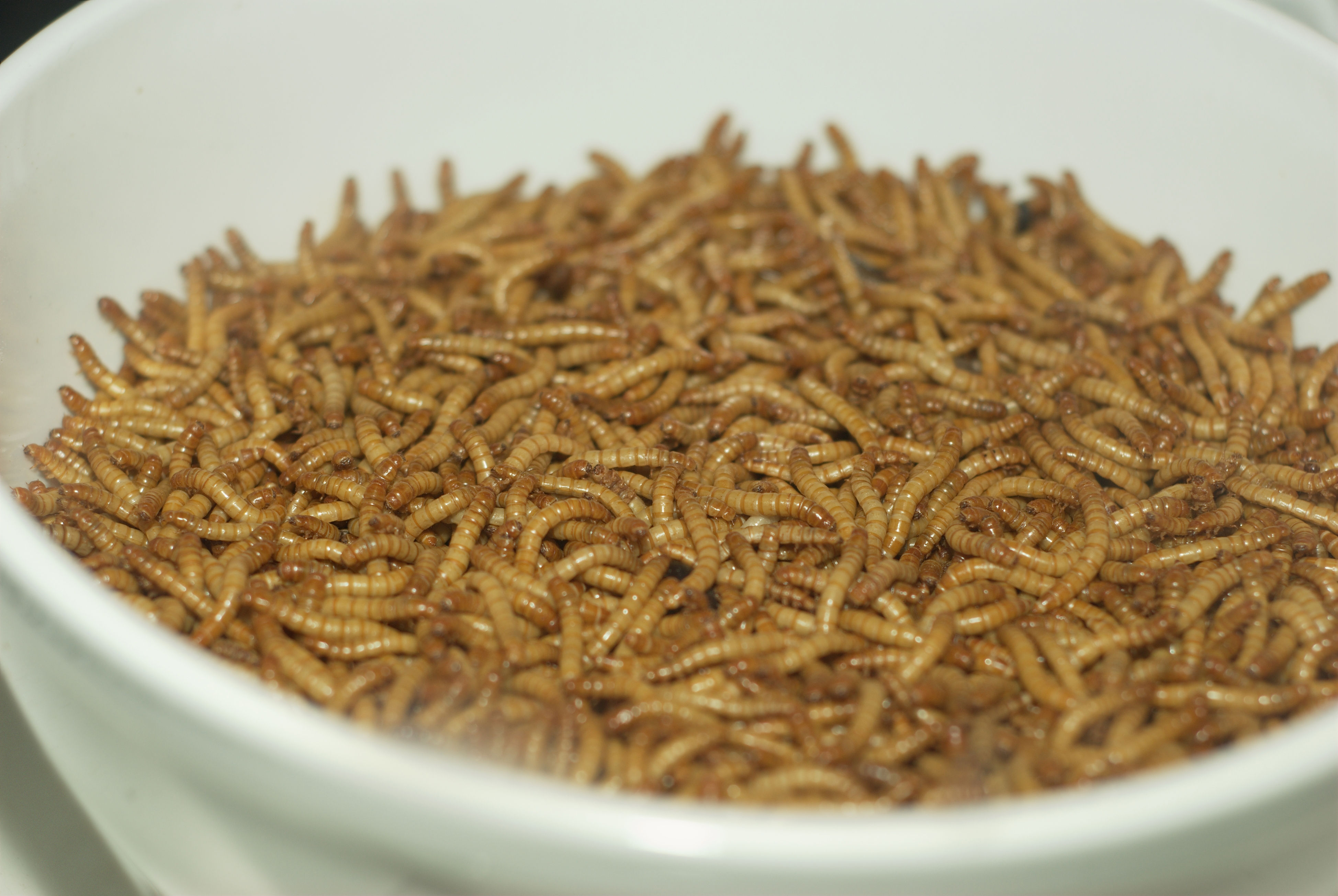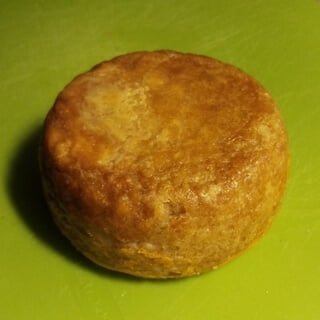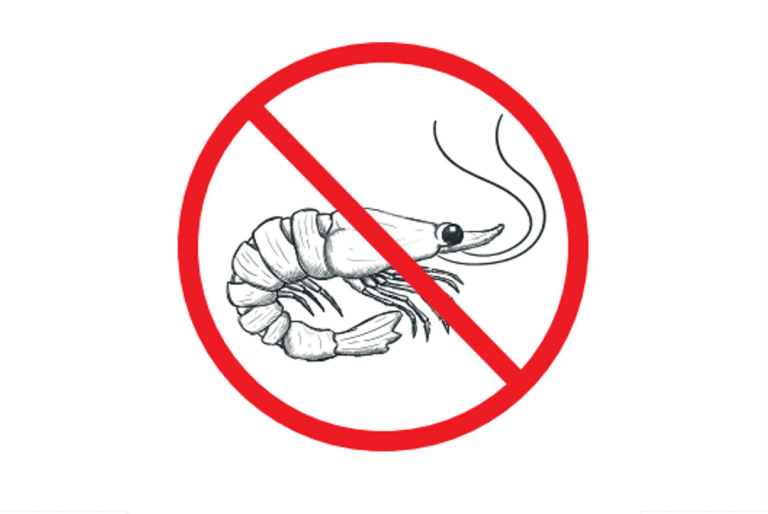
Edible Mealworms: All Facts You Need to Know

Edible Insects – Photo credit to Wilhelm Thomas Fiege
1 The basic facts about mealworms
1.1 What are mealworms?
Mealworms are not independent animal species or even worms: the mealworm is the second stage in the lifecycle of a beetle. Mealworms are the larval form of the mealworm beetle, tenebrio molitor, a species of darkling beetle. Like all holometabolic insects, they go through four life stages: egg, larva, pupa, and adult.
This beetle makes its home in dark, moist places worldwide. Its life starts as a small egg, and after a couple of weeks, the egg will hatch: out pops a little yellow-brown larva. Those larvae are what we call mealworms. The mealworm will spend eight to ten weeks eating, getting ready for its next transformation. Eventually, it will become a beetle with wings, legs, and a dark outer shell.

Tenebrio Molitor beetle – Picture credit to Udo Schmidt
Larvae typically measure about 2.5 cm or more, whereas adults are generally between 1.25 and 1.8 cm in length. Yellow mealworm adults look like typical beetles and are not worm-like in appearance, as their common name suggests. They are dark in color and have a hard shell.
1.2 The anatomy of mealworms
The mealworm is a larva with a hard exoskeleton. Its purpose in life is to burrow, eat, and store fat.
Mealworms’ body consists of the head, thorax, and abdomen.
The legs are attached to the three segments of the thorax. The segments are called the prothorax, mesothorax, and metathorax. Each segment of the thorax has a pair of short legs. A mealworm doesn’t walk very well, but its legs and claws are ideally suited for burrowing.
The head of the mealworm has the mouth and labrum, often called an insect’s upper lip. The labrum is a flattened piece of cuticle at the base of the insect’s “face” and above the mouthparts. The labrum wholly or partially obscures the mandibles and helps hold food in a position when the insect feeds. The mouth and its parts are quite small and designed to eat small pieces of food.
Larval eyes and two antennae are positioned on the mealworm’s head. The eyes are small and poorly developed due to the insect’s burrowing nature. With the antennae, mealworm feels when digging in search of food.
The abdomen consists of nine segments, and the last segment is pointed, containing the anus and a spine. The abdomen contains the digestive tract and stores lots of fat from all the mealworms eat. The larvae need the fat later to transform into a pupa and an adult beetle. Before the transformation, nearly 30% of the body weight of mealworms is fat.
The common name mealworm comes from the cylinder-shaped larvae (caterpillars) with yellow coloration with brownish rings on the body segments. The larval body turns progressively harder as they grow.

Mealworms – Picture credit to Aj Cann
1.3 Why are people interested in mealworms?
1.3.1 Mealworms in scientific research
Mealworms are often used for biological research because they are relatively large and easy to rear and handle. Therefore, they are often used to prove basic biology, biochemistry, evolution, immunology, and physiology concept studies.
1.3.2 Mealworms as pests
Mealworms also have a bad reputation as pests because they feed on stored grains and dry goods. The pests contaminate all products they eat, which leads to costly food losses. Residents who accidentally ingest raw yellow mealworms may have gastric discomfort, but the pests do not transmit diseases.
Homeowners often find yellow mealworms in neglected areas of homes prone to humidity. These pests love forgotten bagged or boxed items in kitchen pantries. Yellow mealworms are common wherever stored food becomes damp or grows mold. Mealworm larvae are among the largest insect larvae that infest stored products. Yellow mealworm infestations are usually a sign of poor sanitation.
A female yellow mealworm will lay eggs in grain products, so tainted bags of flour can start an infestation. Garden or birdseed left in outbuildings also attract pests.
1.3.3 Not only a pest
Mealworms aren’t just pests. They are an important part of the ecosystem because their eating habits and preference for dark and moldy environments enable them to help decomposition in the wild. They are also an important food source for many birds, other insects, reptiles, and rodents.

Robin with A Mealworm – Picture credit to FS Phil
1.3.4 Where do mealworms come from?
Mealworms probably originated in the Mediterranean or Africa but are now present in many areas due to human trade and colonization. Archeologists trace the oldest records of mealworms to Bronze Age Turkey. Still, for example, there are no finds of mealworms from ancient Egypt, and records from the British Isles and northern Europe are from a later date.
1.3.5 Mealworms as feed and pet food
Many pets are insectivores in their natural habitats. Therefore, mealworms have been around as pet food for captive reptiles, hedgehogs, tarantulas, fish, and birds. You can also give mealworms to wild birds in bird feeders, particularly during the nesting season. Furthermore, mealworms are excellent fishing baits!
Mealworms have a high protein content, and their use in bird farms is increasing. They are commercially available in bulk and typically in containers with bran or oatmeal for food. Commercial growers incorporate a juvenile hormone into the feeding process to keep the mealworm in the larval stage and achieve an abnormal length.
Mealworms – Video credit to FS Phil
1.3.6 Mealworms as food for humans
Mealworms are edible for humans and processed into several insect food items in food retail.
The most common ingredient made from mealworms is mealworm powder (sometimes called mealworm flour) which you can buy as pure or flavored. You can add it to almost any food to give flavor and increase protein content. An easy way to start is to try mealworm powder on yogurt.
As insects like crickets and mealworms contain a lot of proteins, many entoprenuers have come to the idea of making insect protein bars. Unfortunately, many insect protein bars on the market contain only a tiny amount of insect powder. The most important reason has been cost, as insect protein powder is more expensive than the other ingredients. On the other hand, within the EU, regulations also limit the content of insects in baked products to 10 – 15%%. Hopefully, this will change in the future.
Other typical food products containing mealworms are protein powder mixes, burgers, bread, cakes, pâté, sausages, and whole seasoned and roasted mealworms. Mealworms have also been incorporated into tequila-flavored novelty candies, but mealworms are not traditionally served in tequila. Instead, the “tequila worm” in certain mezcals is usually the larva of the moth Hypopta agavis.
Only imagination limits the variety of foods where mealworms can be used. See more from Bugburger’s “The big list of edible insect products!“.

1.3.7 What do mealworms taste like?
Ready-to-eat, oven-dried and crispy mealworms have a discreet umami taste that leaves a light, nutty aftertaste. Eat them as snacks or use them as an ingredient when cooking. They go well with more or less everything.
We highly recommend trying mealworms from different producers because their taste depends on the feed they eat. Depending on their diet during their last 2-3 days, the taste of mealworms can differ from slightly unpleasant to very delicious!
We at Party Bugs must admit that we were not too fond of the taste of mealworms as we tried them for the first time in 2018. The taste was mild, but we wouldn’t say we liked the not-so-delicious aftertaste, which stayed for minutes in our mouths and returned time after time for hours. We used to say that those mealworms “farted” in our mouths. Those mealworms came from one of the biggest mealworm producers in Europe, and in 2021, their worms still taste the same. The problem seems to be that the big breeders concentrate on producing animal feed efficiently. So far, they have not been interested in developing the taste of mealworms meant for human consumption.
Later, after tasting mealworms from other producers, we changed our minds. Mealworms can have a very delicious taste without any unpleasant aftertaste.
At Party Bugs, we like mealworms so much that we created a new Party Bugs product line using mealworms.
We first ordered samples and tasted mealworms from dozens of breeders to find roasted mealworms with a perfect taste. Then we carefully developed the flavors and designed the world’s most beautiful insect snack products.
We are very proud of Party Bugs’ new mealworm products. Look how beautiful Party Bugs Smokey BBQ mealworms we created! And that is only one of our mouthwatering mealworm snacks. Find more mealworm products in our Party Bugs Shop and try them! They taste amazing!
Try Party Bugs’ delicious, seasoned mealworm snacks!
1.3.8 Nutritional values of mealworms
Mealworm larvae contain significant amounts of nutrients.
One study shows that the living mealworm contains 20% protein, 13% fat, 2% fiber, and 62% moisture, while the dried mealworm contains up to 60% protein, 28% fat, 6% fiber, and 5% moisture.
But actually, the nutritional value of mealworms varies depending on the feed they have been given. One hundred grams of raw mealworm larvae can have more than 200 calories and anywhere from 14 to 25 grams of protein. Furthermore, their potassium, copper, sodium, selenium, iron, and zinc levels rival beef. They also have a greater vitamin content by weight than beef, B12 not included. Finally, mealworms contain essential linoleic acids.
According to the EU food safety agency (EFSA), the yellow mealworm is safe for human consumption.
1.3.9 The history of mealworms as food
The West has only recently woken to see baked or fried mealworms as a healthy snack food. Still, the rearing and consumption of mealworms go back centuries. Mealworms have historically been consumed in many Asian countries, especially Southeast Asia. You can find them in food markets and buy them as street food alongside other edible insects.
Mealworms are easy to raise, which has made them popular in many parts of Southeast Asia. You can feed them with fresh oats, wheat bran, or grain and give them sliced potato, carrots, or apples as a moisture source. Rearing mealworms requires only a tiny amount of space.
1.3.10 Mealworms can eat plastic!
In 2015, researchers discovered that mealworms could eat polystyrene and that there was no difference between mealworms fed only Styrofoam and mealworms fed conventional foods during the one-month duration of the experiment. Mealworms can eat an all-plastic diet and not die thanks to the microorganisms in their gut responsible for the fantastic job. Still, the process is inefficient as it takes around 3 000 to 4 000 mealworms about a week to eat one styrofoam coffee cup. The degradation of polystyrene also stops when the microorganisms are killed by giving antibiotics to the worms.
The degradation is also incomplete when mealworms eat polystyrene — the material used in Styrofoam and often found in packaging — as only half of their excrete is carbon dioxide. The other half of the excrete consists of partially degraded particles and chemicals like flame retardant sometimes added to the plastic. This raises concerns that plastic-eating mealworms could actually add to the growing problem of microplastics — tiny pieces of plastic that can end up in the food chain.
So, mealworms cannot only eat various forms of plastic, but they can also consume potentially toxic plastic additives in polystyrene with no ill effects. On the other hand, as the poisonous chemicals didn’t accumulate inside the mealworms, they wouldn’t be passed up the food chain. That is essential information when using mealworms as a protein-rich food for livestock like chickens and pigs. So, you can also use mealworms as a safe, protein-rich feed supplement for humans, or you can fry them on your frying pan and eat them! YUMMY!
Mealworms are not the only insects eating plastic. Also, wax worms can eat polyethylene and escape if you want to carry them around in a plastic bag!
2 Breeding mealworms
In this article, we don’t write an instruction book on mealworm breeding and farming because there are already plenty of instructional web pages about breeding mealworms. Instead, we tell you some less-known but interesting facts about the outputs of mealworm breeding.
2.1 Did you know an aftermarket exists for everything you grow at a mealworm farm?
The outcomes of mealworm breeding are:
- mini mealworms
- middle-sized mealworms
- big mealworms
- beetles
- frass
- skins
2.1.2 Demand for Different -sized Mealworms
Mealworms are 2,5 cm long before they curl up into their pupal form. Still, it all starts from tiny, tiny larvae from tiny, tiny eggs. These newly hatched larvae are demanded by people growing tiny, tiny fish or carnivorous tiny, tiny insects in insect zoos. For example, baby tarantulas eat baby mealworms and insect children eating insect childer is totally normal in the insect world.
The bigger the mealworms grow, the bigger birds, tarantulas, reptiles, and fish eat them. The biggest larvae are popular as fish baits and mealworm snacks for us humans.
Chicken loves grown-up beetles, and catching a beetle is probably a chicken’s greatest joy during an otherwise dull day.
The usage of mealworms and beetles is straightforward, as someone or something eats them away. Now it is time to go to more exciting outputs of mealworm breeding.
2.1.3 Frass, Mealworm Skins, and Chitin
What is mealworm frass?
Mealworm frass consists of mealworm castings, feed rests, and insect skins. Because mealworm frass is rich in nitrogen, potassium, and phosphorus, plants just love this nutritious blend when added to the soil. Frass is a safe, all-natural soil additive that is a fertilizer and improves microbial activity.
What is chitin?
Chitin (/ˈkaɪtɪn/ KY-tin) is a structural component of arthropod exoskeletons, fungi cell walls, mollusk shells, and fish scales. Your farm produces it as the sheds of insect larvae as they molt (in the case of mealworms).
Health effects of chitin on plants
Chitin helps plants to defend against insect pests.
When there is a lot of chitin around a plant, the plant thinks there are a lot of pests present.
Plants have multiple immune receptors to chitin and its degradation products. When these receptors get activated in plants, it triggers an immune response. As a result, plants can better defend themselves against insect pests.
Added chitin in the soil triggers plants to think that insects are attacking. To defend against the attack, plants strengthen their cell walls and release natural insect toxins. The fake pest attack using added chitin helps plants grow stronger and also helps them withstand actual attacks by pests later.
In agriculture, chitin may be used to boost plant defenses against disease and as a fertilizer.
Chitin protects plants in another way, too. When there is a lot of chitin and its degradation products around a plant, pests think there are other pests present, and they search for another plant with less competition among pests.
Health effects of chitin on humans
We humans do not produce chitin, but we have an enzyme called chitinase that degrades it. Chitinase is present in human gastric juice, making chitin digestible. Chitin and its degradation products are sensed in the skin, lungs, and digestive tract, initiating an immune response and potentially conferring protection against parasites. Allergies to dust mites and shellfish are often due to a chitin allergy.
The chitin obtained from the insect food and its breakdown products, chitooligosaccharides and chitosan, operate like dietary fiber and lower the blood’s cholesterol. They also have antioxidative, anti-inflammatory, and anti-cancer effects. Furthermore, researchers have also found that chitin and its breakdown products will prevent the growth of the most harmful intestinal bacteria.
Read more about the health benefits of chitin for humans here.
Other uses of chitin
- Because they stimulate an immune response, chitin and chitosan may be used as vaccine adjuvants.
- Chitin may have applications in medicine as a component of bandages or for surgical thread.
- Chitin is used in paper manufacturing as a strengthener and sizing agent.
- Chitin is used as a food additive to improve flavor and emulsifier.
It is sold as a supplement as an anti-inflammatory agent to reduce cholesterol, support weight loss, and control blood pressure. - Chitosan may be used to make biodegradable plastic.
3 FAQ / common questions and answers about mealworms
Are mealworms the same as superworms?
No. The mealworm (tenebrio molitor) and the superworm (zophobas morio) are different species.
The superworm is around 5x larger than a mealworm when considering girth and length. Most of the size difference comes from the superworm having more chitin than mealworms do., and this gives them less meat but a higher calcium, fiber, and fat concentration.
Giant mealworms are regular mealworms (tenebrio molitor) that have been treated with a hormone to delay pupation, which allows them to grow to a larger size.
Can humans eat freeze-dried mealworms?
Yes, but before eating freeze-dried mealworms, make sure that the mealworms are bred for human consumption and bleached before freeze-drying.
Can you eat cooked mealworms?
Yes, but you should only eat mealworms bred for human consumption.

Mealworms – Picture credit to Peter Halasz
How do I feed mealworms to my pet?
Your pet probably loves mealworms as such, but before giving mealworms to your pets, you need to coat the worms with calcium powder. The calcium powder helps balance the amount of phosphorus that mealworms contain, and too much phosphorus in the diet can cause animals to stop absorbing calcium correctly. You can do the calcium coating to your mealworms by sticking them in a paper or plastic bag with calcium powder inside and gently shaking them until they are evenly coated.
Place the calcium-dusted mealworms in an escape-proof bowl for your pet to eat from, or you can try hand-feeding them from your palm or with a pair of soft-tipped feeding tweezers.
Feeding mealworms to your pet is easy; you can add them to a bowl and let your animal feed on them or hand feed them. They don’t easily escape from a dish as they don’t have legs.
How do I feed my mealworms to make them more nutritious feed for my pets? (so called gut-loading)
Feeder insects lose some nutritional value after staying mostly dormant for multiple weeks. Gut loading is the process of feeding insects a diet high in vital nutrients before feeding those insects to other animals. The majority of feeder insects are deficient in calcium and contain excess phosphorus. Excess amounts of phosphorus can be dangerous to pets, and that’s why it is crucial to give highly nutritional food with added calcium and vitamins to your mealworms.
How do I store mealworms?
You can store alive mealworms in a fridge in a jar with breathing holes.
Keep dried mealworms in the dark, dry, and at room temperature.
How long do mealworms last?
Living mealworms last longer the colder the temperature. But don’t freeze them!
Dried mealworms have a shelf life of 6 – 15 months.
How long do mealworms live for?
The general life span of mealworms is about one year.
Is chitin toxic to humans?
No, chitin is not toxic, dangerous, or harmful to humans. Chitin is a natural polysaccharide that is a significant component of the exoskeletons of crustaceans and insects. The cell walls of some fungi contain chitin, too. While chitin can cause allergic reactions in some individuals, it is not toxic and poses no harm to human health. However, we advise you to carefully handle products containing chitin, such as crab shells, to avoid cuts or punctures that can become infected.
Mealworms are Novel Food, but what does it mean?
On 9 February 2022, EU Commission authorized the placing on the market of frozen, dried, and powder forms of yellow mealworm (Tenebrio molitor larva) as a novel food.
Novel Food is defined as food humans had not consumed significantly in the EU before 15 May 1997.
‘Novel Food’ can be newly developed, innovative food, food produced using new technologies and production processes, as well as food traditionally eaten outside of the EU.
The underlying principles underpin Novel Foods in the European Union:
- Novel Foods must be safe for consumers.
- Novel Foods must be properly labeled so as not to mislead consumers.
- If Novel Food is intended to replace another food, it must not be nutritionally disadvantageous for the consumer.
Pre-market authorization of Novel Foods based on an evaluation in line with the above principles is necessary. The authorization takes years and costs a lot of money. Therefore, we have only recently started seeing authorized edible insect species on the EU market.
All mealworms Party Bugs uses are certified as Novel Food! Our supplier has a license to breed mealworms with the right of Novel Food Dossier ‘Frozen and dried formulations from whole yellow mealworm (Tenebrio molitor larva) as a Novel Food pursuant to Regulation (EU) 2015/2283′. Said right has been granted to licensee by means of Regulation (EU) 2022/169.
Mealworms grown under a Novel Food licence are used in both Party Bugs and Bug Bazaar products.
What do mealworms eat?
What do mealworms like to eat the most? Mealworms can be a pest to humans. They enjoy cool, dark places like cabinets, barns, cellars, basements, or wherever grain (such as cornmeal) is stored. They get water from eating fruits and vegetables that contain water. They also like to eat decaying matter, whether a dead animal or a dead plant. They won’t feast on anything that is living.
Which mushrooms contain chitin, and what is its function in mushrooms?
Chitin is primarily found in the exoskeletons of crustaceans and insects and the cell walls of some fungi. Some types of mushrooms, such as Agaricus, Lentinus, and Schizophyllum, contain chitin in their cell walls, but many other types of mushrooms do not. For example, baking yeast does not contain chitin, but mushroom-looking fungi, like delicious portobello and chanterelle mushrooms, have a lot of chitin.
In fungi, chitin creates the cell wall; it works much like cellulose, creating other plants’ cell walls. The function of chitin in these fungi is similar to its role in other organisms: it provides structural support and helps to maintain the integrity of the cell wall. Chitin strengthens fungi, giving them the durability to push through plant matter and soil as they grow and surface. In fungi, chitin can also play a role in protecting the organism from predators or environmental stressors.
Why are some of my mealworms white?
Mealworms, like superworms and other species, molt their skin. When they are freshly molted, they will look white; after a few hours, they will return to their original color. Freshly molted mealworms are a delicacy for your reptile; they love the soft, freshly molted ones and will often pick them out of a bowl first if given a choice between those and regular mealworms.
Why do mealworms turn black?
Pupae might die and turn black if not given enough moisture at the end of the larval stage.
What is the Nutritional Information for Mealworms
Why was I told that mealworms are bad?
Mealworms also have a bad reputation as pests because they feed on stored grains and dry goods.
Mealworms have a bit of a bad reputation as a feeder, too; they do contain a high amount of chitin compared with superworms and other feeders, making them harder to digest than other insects. However, as long as you enact the proper husbandry in temperatures, lighting, hydration, and anything else that your particular species needs to thrive, you shouldn’t have an issue.
Summary
Mealworms are also high in protein, so you know they will do a lot of good for you. Often used as a nutrient booster, they give you the same amount of protein as beef but with no environmental effects.
Mealworms are already mass-produced in large quantities as animal feed, and mass production for consumption is the next step.
References to articles about mealworms
Campbell, N. A. (1996). Biology (4th ed.). Benjamin Cummings, New Work. ISBN:0-8053-1957-3.
Cheung, R. C.; Ng, T. B.; Wong, J. H.; Chan, W. Y. (2015). “Chitosan: An Update on Potential Biomedical and Pharmaceutical Applications.” Marine Drugs. 13 (8): 5156–5186. doi:10.3390/md13085156
Elieh Ali Komi, D.; Sharma, L.; Dela Cruz, C.S. (2017). “Chitin and Its Effects on Inflammatory and Immune Responses.”, Clinical Reviews in Allergy & Immunology. 54 (2): 213–223. doi:10.1007/s12016-017-8600-0
Karrer, P.; Hofmann, A. (1929). “Polysaccharide XXXIX. Über den enzymatischen Abbau von Chitin and Chitosan I.”, Helvetica Chimica Acta. 12 (1) 616-637.
Mariod, A.A. (2020). Nutrient Composition of Mealworm (Tenebrio molitor). In: Adam Mariod, A. (eds) African Edible Insects As Alternative Source of Food, Oil, Protein and Bioactive Components. Springer, Cham. https://doi.org/10.1007/978-3-030-32952-5_20
Tang, W. Joyce; Fernandez, Javier; Sohn, Joel J.; Amemiya, Chris T. (2015) “Chitin is endogenously produced in vertebrate.” Curr Biol. 25(7): 897–900. doi:10.1016/j.cub.2015.01.058


















This Post Has 3 Comments
Thanks for explaining why different mealworms can have different colors. I’d like to know more about live mealworm pet food soon because I plan to take care of a chameleon someday. It would be best to start learning more about the different kinds of bugs that it could eat.
I noticed one of your products is “smokey”. I avoid smoked food because of the likelihood of carcinogens.
Could you please also respond by email.
Dear, Sapoty!
Thank you for commenting.
We don’t smoke our products. Instead, we use smoke aroma.
Liquid smoke is a concentrated liquid flavorant made from the smoke produced by burning wood chips, sawdust, or other wood materials. You can add a smoky flavor to food, particularly meats, without actually smoking the ingredients.
Liquid smoke is made from smoke that has been condensed and purified. Due to the filtering process, liquid smoke is safer than food smoked over a live fire.
It is generally safe to consume liquid smoke in small amounts as a flavoring agent in food. However, as with any food ingredient, it is important to use it in moderation and to follow the instructions on the label. It is also a good idea to consult with a healthcare professional if you have any concerns about using liquid smoke.
Currently, Party Bugs uses smoke aroma in one product only. We offer many other products to choose from for people who have concerns about smoke aroma.
Best regards,
Mr. Party Master
Comments are closed.